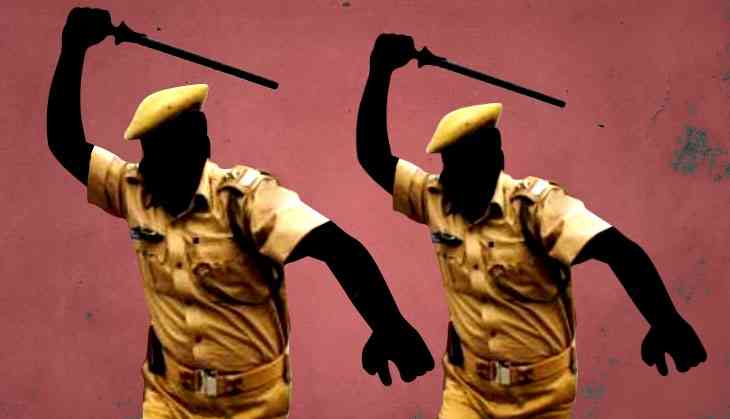Chharas of Ahmedabad face brutal side of Gujarat Model as cops go on rampage

The brutal face of 'Gujarat Model' was on display once again in Chharanagar locality of Ahmedabad on the night intervening Thursday and Friday with the cops creating mayhem. A large number of them allegedly went on a rampage damaging dozens of vehicles, breaking into houses and assaulting the local residents including women and children in this locality that primarily houses the members of the Chhara community that is a De-notified Tribe (DNT).
There are two versions coming for what sparked the police action. The first one is that the there was an altercation between two Chhara youth in an inebriated state and a policeman in which the latter was assaulted. The cops took it upon their ego and retaliated with the action. The second version coming out is that the police were carrying out a raid against distilling of illicit liquor and the Chharas tried to stop them from carrying out their job while indulging in rioting.
Whatever the case, the matter should have ended with the cops booking the accused and arresting them instead of resorting to large scale vandalism and assault on the Chhara community that stands out as one of the most vulnerable and marginalized societies in Ahmedabad.
Reports say that the police have detained around 30 Chharas and slapped multiple charges on them. Theatre activist Dakxin Chhara, who belongs to the community and is among the few educated people in the area told Catch News, “The violence from the cops continued from around midnight till 5 am. It was only after we managed to talk to the people in the National Human Rights Commission (NHRC) who in turn called up the Gujarat chief secretary and the directions were further conveyed to the Ahmedabad Police Commissioner that the violence stopped. Among those who were assaulted are photo journalist Pravin Indrekar and documentary maker Atish. I am myself a witness to the cops vandalizing no less than two dozen vehicles in the lane where I live.”
Dakxin has posted a series of pictures on the social media depicting the brutality of the police assault. The locals allege that howls and cries emanating from fear could be heard from women and children throughout the night.
Gaurang Jani, an who teaches Sociology at Gujarat University, points out that being a DNT, the Chharas have always remained on the margins in Ahmedabad. Because of their geographical, social, cultural and economic marginalization, they have been among the most vulnerable communities.
DNTs are tribes whose members under the British rule were listed under the Criminal Tribes Act of 1871 as criminals. They were described as tribes whose members were habitual offenders of non bailable offences. Their movement was restricted and they had to register with the local magistrate. It was in 1952 that the notification describing them as criminal tribe was repealed under the Criminal Tribes Act of 1952 and they were 'de-notified' or made 'Vimukt' (free). The DNTs celebrate August 31 as 'Vimukta Diwas' to mark the day when the stigma of being a criminal tribe was removed from them.
Jani explains, “For the Chharas the stigma continued in social terms and they continued to face discrimination. Their children would be pointed out in government schools as being those from a DNT. The state and the civil society kept them at a distance and their marginalization continued.” he said.
With the result a large number of people from this community remained uneducated and took to petty crime and distilling of illicit liquor in a state where there is prohibition.
“It is because of the interventions by activists and literary personalities like Ganesh Devy and Mahasweta Devi that there has been some turnaround. Over the last few years the community has produced a lot of lawyers and also a cultural leadership in the form of theatre activists, journalists and film makers,” he added. Budhan Theatre, of which Dakxin is a part, has made a name for itself and has been coming out with people centric productions regularly.
Jani pointed out that while the community stood stigmatised, the government did nothing to bring it into the social mainstream. Even the political leadership has shunned the community as it does not comprise a vote bank because of its small numbers.
Because of these factors the police have always treated the members of the community with scorn. “The Police need to be sensitized about these communities. Their attitude has to change,” Jani added.
A large number of intellectuals and activists in Ahmedabad have thrown their weight behind the Chhara community on the issue of the police assault on its members. A series of protests are being planned in the days to come.
The Chharas have demanded that all those arrested by police be released. They say that none of those picked up by the police are into illicit distillation of liquor. Those picked up include journalists, lawyers and theatre activists and this punctures the police theory of raiding illicit distillation centres.
“If there is no positive action in the next couple of days, we will organise a massive rally in Chharanagar in which DNTs from Gujarat as well as other states would participate,” Dakxin said.
Such police brutality is nothing new in Gujarat whose model of governance is marketed by Prime Minister Narendra Modi and Bharatiya Janata Party's (BJP) national president Amit Shah. This correspondent has first hand experience of the trail of terror it leaves among the children and women in areas where these assaults are carried out. More than a decade back, the police had carried out a similar assault in a slum inhabited primarily by Muslims on the outskirts of Godhra. The result was that children in those houses would start shrieking and trembling with terror whenever an outsider would enter their homes. “They think the cops have returned to thrash their parents once again,” a woman had told this reporter.
The episode at Chharanagar have deep socio-political and socio-economic dimensions to it. It also reveals how targeting the marginalised has become a new normal like the lynchings of the poor and vulnerable.


